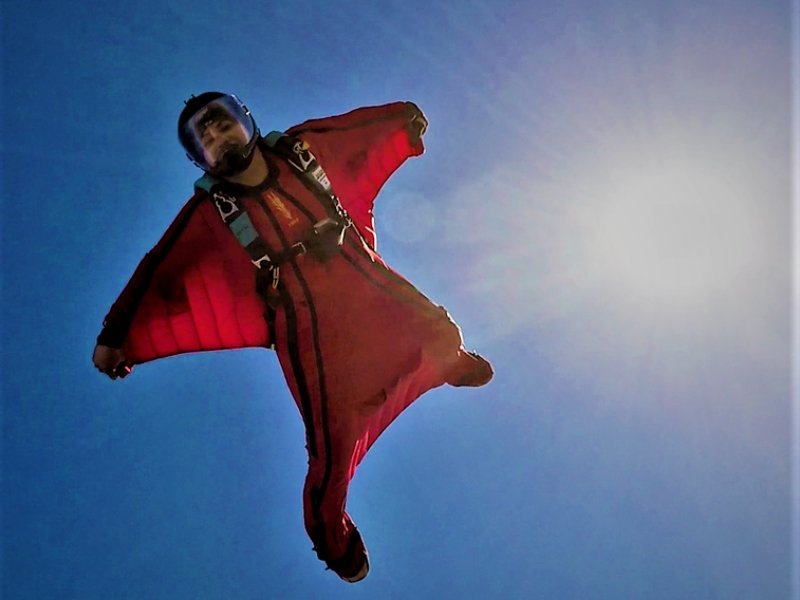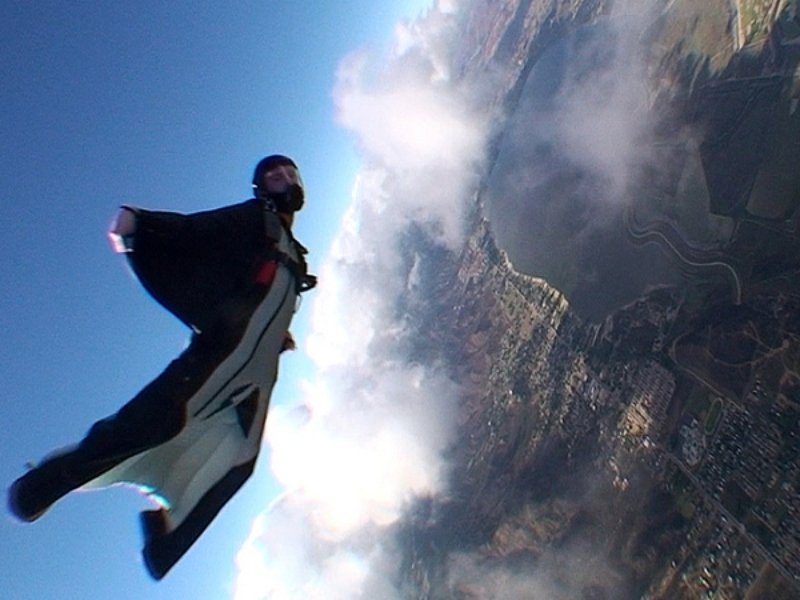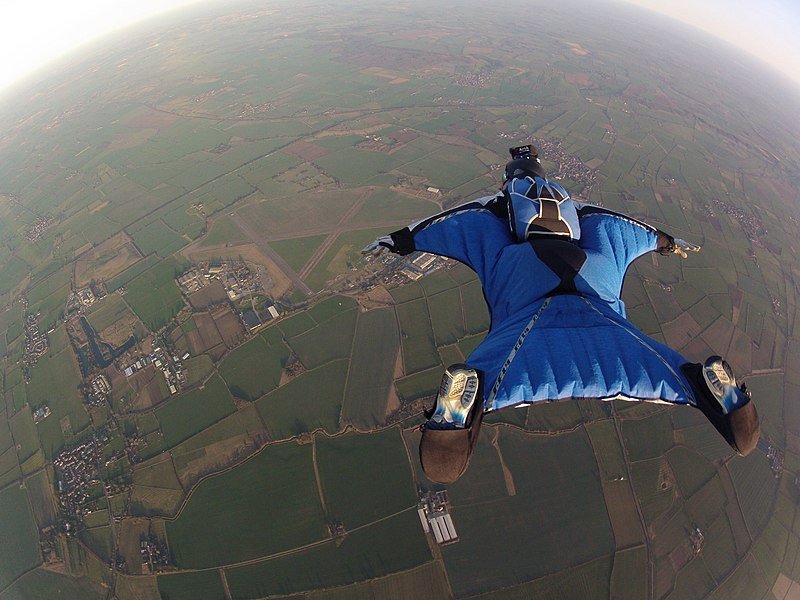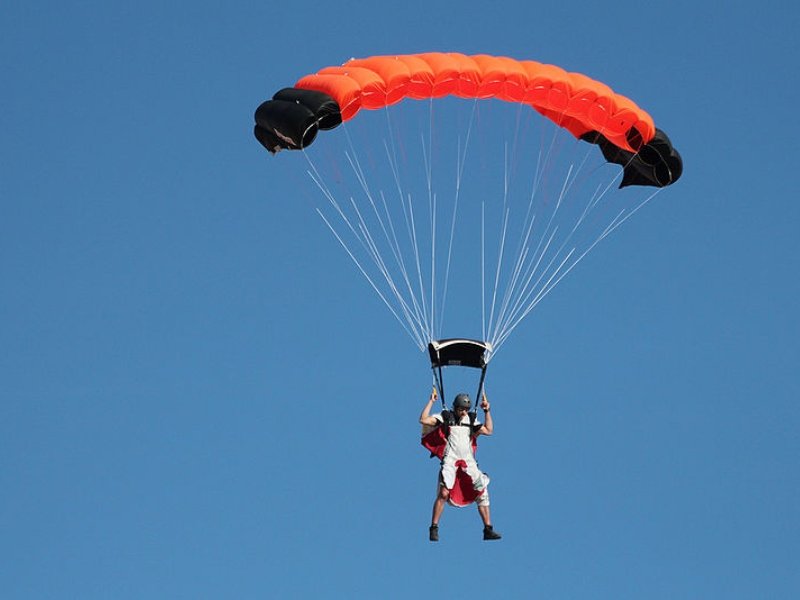You’ve probably seen a wingsuit flyer soaring through the air at an almost horizontal angle and been impressed by the speed. Wingsuit flying is a totally different experience from skydiving or base jumping freefall. So how fast do you go in a wingsuit?
There’s a lot of physics involved, but professional wingsuiters can pick up some incredible speeds and travel remarkable differences. As wingsuit technology improves, so do the speeds and distances the average wingsuiter can travel.
Let’s take a look at how fast an average wingsuit pilot will travel and what the top-end speeds professionals reach. We will also look at the distances covered and how to slow down and stop when traveling at such high speeds.
How fast can you go in a wingsuit?

Wingsuit flyers use the added materials and webbed fabric between their legs and arms to obtain near-horizontal flight. The increased surface area and aerodynamics of the wingsuit allow pilots to create glide and momentary even lift. As the sport has grown in popularity through the 1990s and early 2000s, so has the tech. The top speeds and average distances have regularly been increasing over recent years.
A skydiver or wingsuiter in freefall will gain speeds of around 120 MPH in the belly-to-earth position and up to 180 MPH in the head-to-earth position. The speed obtained relies a lot on the surface area. In wingsuit flying, the increase in surface area allows the pilot to transfer some of that downward speed and momentum into glide. The speed of the wingsuit flight depends on the angle of the glide, as the less horizontal a pilot is, the more downward force and more incredible speed they can achieve. In a typical glide ratio of 3:1 (this means traveling three feet horizontally for every one foot of vertical fall), a wingsuiter can travel at around 100 MPH.
It can take a lot of time, skill, and practice to master the wingsuit ratio and reach optimal speeds. Wind speed can also play a crucial part in the speeds you reach, and with the proper knowledge, an experienced wingsuiter can use wind speed and direction to maximize their glide speed. So while 100 MPH at a 3:1 glide is a speed most wingsuiters will progress to achieve, those who master aerodynamics will go on to reach much greater speeds.
What is the fastest wingsuit speed?

At its most efficient level, wingsuit flyers can reach horizontal speeds above 200 MPH (and descent rates as low as 25 MPH). These incredible speeds not only surpass the average speed of a belly-to-earth freefall but also that of a head-to-earth freefall.
Incredibly, the fastest wingsuit flight on record is 246.6 MPH. A British wingsuiter, Fraser Corsan, achieved this feat on 22 May 2017. The Guinness Book of Records officially recorded it, although the FAI does not formally recognize it. Corsan started his initial jump as 35,508 feet over David, California. Coran’s ability to reach such a speed was undoubtedly helped by his knowledge, working as an Aerospace Safety Engineer.
It’s important to note that such speeds use specialist wingsuits with optimal aerodynamics. Due to the speeds and instability of these suits, they can only be worn and used by elite professionals. Absolute mastery is needed to reach these advanced speeds in professional-level wingsuits safely. Even the slightest error or misjudgment can result in a flight out of control and possibly fatal results.
How far can you fly in a wingsuit?

While horizontal wingsuit speed surpassing vertical freefall is impressive, so are the distances that can be achieved. How much distance you cover with a wingsuit depends on a few different things; the altitude you jump from, the wingsuit you are wearing (and your skill level), the angle you fly at and speed you achieve, the air density, and your deployment height. When you factor in all these things, there’s a big difference between the distances a newbie can reach compared to a seasoned professional.
At the beginner level, many wingsuiters will jump from typical skydiving heights of around 13,000 feet. Wearing a starter-level wingsuit (with optimal control and reduced speed), a new wingsuiter can get approximately 2 to 3 minutes of flight if deploying at 4,000 feet. The distance can still depend on your ability, as well as your strength and stamina and ability to hold a flat body position, and good glide ratio. It’s possible, even at a beginner level, to reach and pass distances of 8 KM.
At a professional level, significant distances can be reached. In 2015 a Navy Seal named Andy Stumpf jumped from 36,000 feet in a wingsuit, going a distance of 29.38 KM. But he only held on to that record for a year after U.S. wingsuiter Kyle Lobpries achieved a distance of 30.4 KM. Lobpries’ flight lasted 8 minutes and 27 seconds before he opened his parachute at 1,500 feet. Amazingly, this isn’t the longest wingsuit flight timewise. That record is by Colombian Jhonathan Florez, who flew his wingsuit for 9 minutes and 6 seconds over La Guajira, Colombia, in April of 2012.
How do you stop and land a wingsuit flight?

We’ve covered how fast you can travel and how far, but how do you slow down and land a wingsuit?
When flying at your top speed in a wingsuit, the suit itself will become very rigid while inflated with air. To land, you first have to slow it down. Wingsuiters can slow down using flaring. Flaring is the technique of exchanging forward momentum for momentary lift. This flight configuration slows down the gliding momentum and allows the wingsuit pilot to reduce their glide and angle and get into a relaxed configuration. They can then enter what is more like standard free fall. In a way, it’s a bit like a plane would perform a stall.
Once in the relaxed configuration, the pilot can deploy their parachute just as a skydiver would. It’s crucial not to deploy the parachute too early into a flare, as this can cause complications; there is an art to deploying smoothly and at the right time. Wingsuiters tend to deploy at heights similar to skydivers, around 2,500 to 4,000 feet, depending on confidence, experience, and skill level.


2 Comments
Everything is very open with a precise clarification of the issues. It was definitely informative. Your site is useful. Thank you for sharing!
Thank you, we really appreciate that.